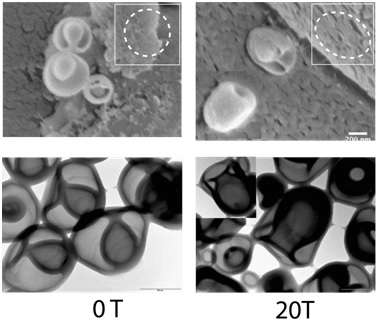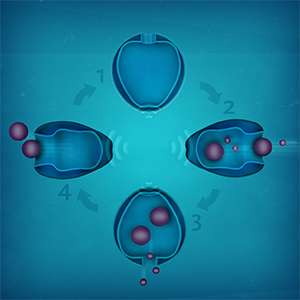Magnetic field opens and closes nanovesicle

Chemists and physicists of Radboud University managed to open and close nanovesicles using a magnet. This process is repeatable and can be controlled remotely, allowing targeted drug transport in the body, for example.
Nanovesicles for transporting drugs to correct locations in the body - that's the idea. On 24 September, chemists and physicists from Radboud University will publish results from a seminal intermediate step in Nature Communications: they have managed to open the vesicles in a reversible process and close them using a magnet.
The nanovesicles look like minuscule, indented balloons. It had already been possible to 'load' them with a drug and open them elsewhere. But this was done using a chemical process, for example using osmosis. Researchers at the Nijmegen Institute for Molecules and Materials (IMM) have now demonstrated the viability of another method.
They have stretched the walls of the vesicles by aligning the molecules in the wall using the strong magnets of the High Field Magnet Laboratory (HFML). Because the strength of the magnetic field is precisely linked to the size of the vesicles, the deformation can be controlled more easily. It is the first time that researchers have managed to make this process reversible: without the magnetic field, the vesicles close, and they open when the field is turned on. After switching the field off, they return to a closed state. This process is repeatable and can be regulated remotely.
HFML researcher Peter Christianen stated, 'Our chemist colleagues published an article recently about a type of nano rockets – vesicles which propel themselves by expelling combustion products. Initially, we wanted to see if we could steer these rockets with magnetic fields, but to our surprise, the vesicles opened during those experiments. This was the start of the current research.' Chemist Daniela Wilson explains how the two lines of research could ultimately be combined: 'Suppose you fill the vesicle with fuel and medicines, then you could transport the vesicle by creating a small opening and only allow the fuel to get out. Then you could unload the remaining cargo at the destination.'

Fine-tuning
However, this still requires fine-tuning. The researchers will attempt to figure out to exactly what extent does a vesicle deform with a particular magnetic field strength. They will also experiment with different types of wall molecules. Wilson: 'The current bubbles are not suitable for use in the human body, so we are looking for molecules which are. We also hope to find materials for which the same effect occurs in a lower magnetic field - that of an MRI. Then, the technique could be used clinically with MRI scanners. In any case, the first step has been made, we have demonstrated that the technique works.'
More information: P.G. van Rhee, R.S.M. Rikken, L.K.E.A. Abdelmohsen, J.C. Maan, R.J.M. Nolte, J.C.M. van Hest, P.C.M. Christianen & D.A. Wilson. "Polymersome magneto-valves for reversible capture and release of nanoparticles." Nature Communications DOI: 10.1038/ncomms6010
Journal information: Nature Communications
Provided by Radboud University Nijmegen




















